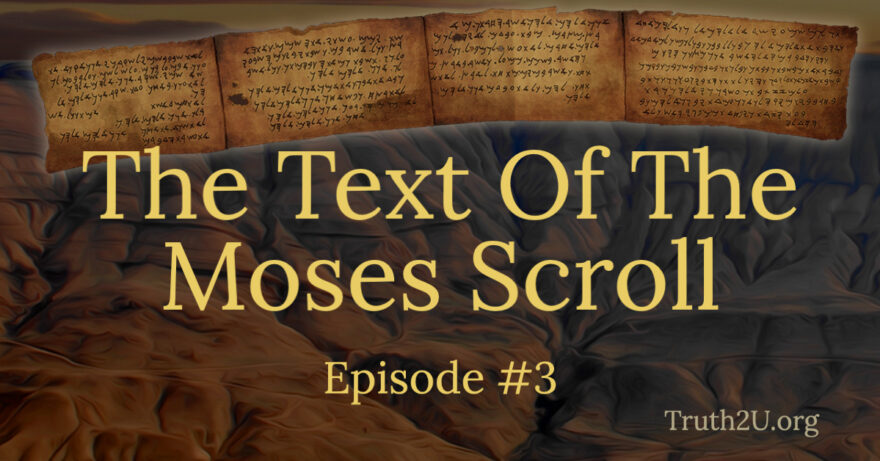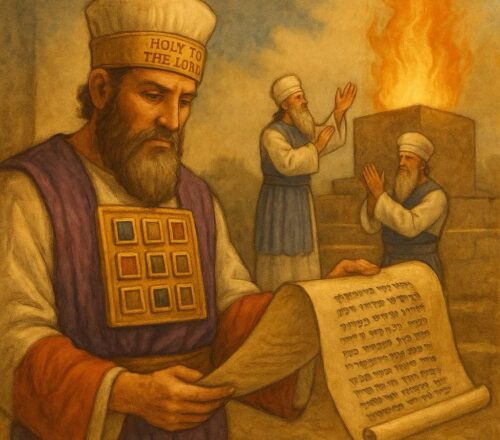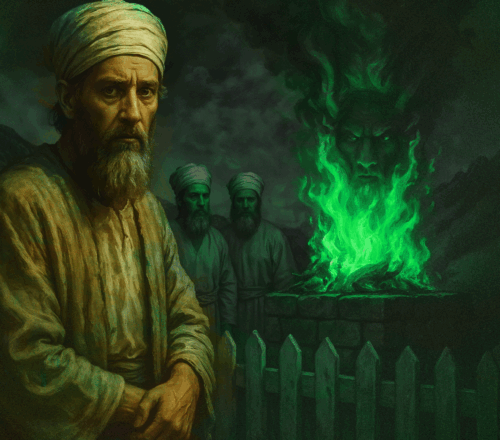The Text Of The Moses Scroll – Episode #3 – Ross K Nichols
In this episode, Ross answers excellent questions from the following comment left by a Truth2U listener:
I find this subject fascinating, but so far have failed to grasp what it is that has both of you believing it is an authentic predecessor to our modern Deuteronomy. We don’t have the originals to perform any tests on. All we apparently have are 19th century artistic renderings. Sure, some of the features which led scholars to reject it as a forgery we have subsequently confirmed to be genuine from the DSS, but the sense I get is that about the only positive speculation to which one can arrive is that this is an ancient document in the same sense the DSS are. The DSS are all over the place (in terms of content and theology) and simply represent texts that were in circulation at the time. Shapira’s scroll simply becomes another such text. What is it that has you so convinced it’s something closer to the original writings of Moses? What reason would anyone have to suppress the commandment to not hate one’s brother in one’s heart, and isn’t it somewhat odd to have that as a commandment along with the command to not murder one’s brother? I mean if you’re considering murdering your brother you probably bear some level of ill will toward him by this point. BTW in terms of the Exodus 6: 3problem, it would be nice if all bases are covered and people are given as much information as possible. Exodus 6:3, as you well know Jono from your Torah Pearls podcast covering parish Vaeira with Nehemia Gordon and Keith Johnson, can be read rhetorically, i.e. it’s just as legitimate to read it as “by my name YHWH was I not known to them?” which solves the problem of the elders to which Moses is sent not knowing said name. (And regardless of when you believe this name was “revealed”, the name YHWH present in Genesis is not surprising at all if Genesis was compiled with the rest of the Torah materials well after the name was made known, possibly from original source tablets as speculated by P. J. Wiseman, whose hypothesis was quite compelling if you ask me.)
WLT





Imagine my surprise to discover my comment has generated an episode in response! I certainly didn’t expect that, but I do appreciate the time you guys took to respond. This is my response to your response–though I do hope to avoid causing you to devote further episodes in response. Discussion here in the comment section would suffice as I know you want to move on to more discussion of the text.
First of all, clearly our modern Deuteronomy is not of 100% Mosaic authorship. From the introduction to the summation, and the anachronisms sprinkled throughout it and other books, the post-Mosaic influence is clear. I have for some time thought as you do that of the five books “of Moses”, Deuteronomy likely contains more original Mosaic content than anything else. Even so, it is written as if it’s a third party’s recollection of Moses’ speech.
That said, I’m not a big fan of the DH/JEDP approach either. Certain chiastic structures in the Torah contain what DH proponents attribute to multiple authors, which present a bit of a problem for JEDP (unless one can reasonably expect the editors themselves to have constructed the chiasms). For Genesis especially I tend to like the Wiseman hypothesis (aka tablet theory) though admittedly that like is grounded about 50% in intellect/evidence and 50% in hopefulness.
Having just listened to this episode, I’m trying to quickly respond while it’s fresh on my mind. Two things in particular came to mind.
Ross, near the end you called Shapira’s scroll a “candidate”. That I can get on board with. It’s a possible candidate to be something more original, IF it is an authentic ancient document. The “IF” is unfortunately complicated by the lack of originals. In this episode you mentioned three (well two and a half) transliterations into Hebrew that were independently done. That’s all well and good, but is hampered by the problem of interpretation. Personally I would place far greater value in a complete artistic rendering that duplicates the original as closely as possible, so that scholars might have a sort of second hand access to the original text. I’m aware of at least some partial renderings, but is there enough, even if pieced together from disparate partial renderings, to provide this type of access to the entirety of the original text? If not, I wish you much success in locating the originals!
This is why I mentioned only the artistic renderings in my previous comment. The transliterations and subsequent translations are not quite enough, for me at least.
Now, on to some of the other textual problems you mentioned in this episode:
1. Geographical problems in Deuteronomy.
2. The problem of where Aaron died and was buried.
3. Differences between the Decalogue in Exodus vs Deuteronomy.
4. Differences in the story of the spies sent into Canaan between Numbers and Deuteronomy.
5. Lack of the blessings in Deuteronomy.
It bears mention that another ancient manuscript of the Torah, the Samaritan Pentateuch, does not suffer from problems #1, #2 or #3. In particular, Deuteronomy 10 which you mentioned in this episode is much different in the SP, matching the descriptions of their travel route and Aaron’s death on Mount Hor elsewhere. The decalogue matches exactly, even the Sabbath command! The differences in the story of the spies remains, and the missing blessings is indeed a perplexing problem.
On might attribute this (and many have over the years) to sectarian correction, but there are many reasons to doubt this. For example, the Vorlage of the LXX logically must predate the work of the Masoretes by some 700-900 years, and the SP, where it differs with the Masoretic substantively around 3000 times, tracks with the LXX in 1900 of those instances (Bearing in mind that ONLY the Torah of the LXX was translated by Jews, and that’s the only comparison being made here.) Further, we have SP manuscripts that are as ancient as the MT manuscripts we have. I recall inspecting some SP manuscripts at Hebrew Union College in Cincinnati a few years ago that are dated to the 1100s.
Further, the SP has always been written in the ancient Hebrew, and uses interpuncts liberally for word separation. (While this has no academic bearing on the argument, right now I’m looking through a copy of the printed SP that was gifted to me by a member of the Samaritan community, and it uses interpuncts throughout to separate each word.)
I say all this because I believe the study of the evolution of the text should incorporate the SP. The Samaritans are Israelites (DNA studies have demonstrated this) and have remained in the land since the days of Joshua (the Assyrians DID NOT exile the entire northern kingdom.) Their Torah has something worthwhile to contribute to the question of originality.
To summarize, I believe that much, though not all, of your argument based on textual problems is (potentially depending on your ability to consider it alongside the MT) rendered irrelevant by the SP. For me, the biggest remaining question is the missing blessings, which is admittedly a stumper.
Nevertheless, without the originals (and perhaps even with them) the Shapira scroll, as I speculated in my original comment, seems to be at best a “candidate” (your word, and something I can agree with) for a legitimate ancient document that could possibly be an earlier form of Moses’ writing. It could just as easily be an ancient sectarian attempt to correct problems seen in the text of its time. As a seeker of biblical truth, I try not to let any presumption interfere with the consideration of new evidence. I find the possibility that it is a legitimate ancient document something that is definitely worthy of consideration, and do not rule it out (my current gut feel is that it is legit.) The jump from there to it being an authentic early form of Moses’ writing is more difficult, at least for me.
Nevertheless I look forward to further developments!
I don’t see a difficulty at all with the possible of the authenticity of this manuscript , I can see it making a lot of people uncomfortable, but what doesn’t now a days. I however find it exciting in light of many things , things we see Jeremiah say as well as some other prophets, and the textual evidence for those who understand the regionally comparative and archaeological evidence is very compelling. I often think about the rituals we don’t have the ability to preform anymore ( via the temple and tabernacle) and haven’t had for over a millennia, And often wonder if God was removing things he never told anyone to do in the first place. I find it all very, very compelling. I’m a Orthodox Jew who attends a kollel, so for me to say something positive about this is no small feat.
My question to you fine gentlemen is this, after reading your book Ross, and knowing your understanding of the region Jonno
Do you suppose that this manuscript could actually be something Moshey’s father in law the Midianite
Kohen Yethro had taken back to Midian and kept and taught after his visit with Moshey after the Exodus of Israel? Considering where it was supposedly found and by who’s land it was supposedly in?
For me this is very interesting regarding Elohim and Yehovah, according to Joseph Smith jr the name of God the Father is Elohim and Yeshua before he became human was Yehovah. Thus it proves in a way that he was correct and that there are two Gods and not a trinity.
I’m not familiar with Joseph Smith jr’s theology, but he may have developed it from Deuteronomy 32:8-9, which says, “When Elyon gave nations their homes and set the divisions of man, He fixed the boundaries of the peoples in relation to Israel’s numbers. For Yehovah’s portion is His people, Jacob His own allotment.” This passage is not derived from the Moses Scroll, which references Elohim alone.